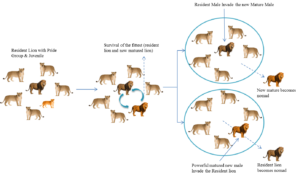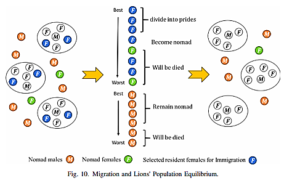In Brief
You will find the best dissertation research areas / topics for future researchers enrolled in Engineering .
• In order to identify the future research topics, we have reviewed the Engineering literature (recent peer-reviewed studies) on the AI in optimization problems
• Nature-Inspired Optimization Algorithm is the recent trend in machine learning.
• Lion Optimization Algorithm (LOA) is one of Nature-Inspired Optimization Algorithm.
• Lion Optimization Algorithm (LOA) is also one of the types of metaheuristic algorithms
• Lion Optimization Algorithm (LOA) is used to solve complex engineering optimization problems.
Over the past decade, several metaheuristic algorithms are developed and most of the metaheuristic algorithms are built by the influence of nature. The nature-inspired metaheuristic algorithms are used to solve complex optimisation problems in engineering. One of the optimization algorithms named the Lion Optimization Algorithm (LOA) is explored in this blog. The LOA developed based on Lion’s distinct lifestyle, population and character of cooperation. The Lion optimization algorithm used to solve engineering optimisation problems like data clustering (Nanda & Panda, 2014), neural networks tuning (Azadeh, Seif, Sheikhalishahi, & Yazdani, 2015), scheduling problems ( Goldansaz, Jolai, & Zahedi Anaraki, 2013; Suresh & Kumarappan, 2013), pattern recognition (Garai & Chaudhurii, 2013), image processing and video processing (Draa & Bouaziz, 2014).
Lion Social Behaviours
Lions were the most socially oriented species of wild cat with a high degree of collaboration and hostility (Jayapal & Subban, 2019). Lions are extremely superior in appearance, social behaviour and strong in sexual dimorphism. The lion belongs to the wild felid family. The lion residents living group is called pride. Usually, a lion pride comprises around five females, cubs, plus one or more male adults. The lion lives in two ways in social organisation, some will be as a resident and some as nomads.

The first social organisation behaviour of the lion is, the young males are removed from their birth pride when they are physically matured (Gope, Dawn, Bhowmik, & Das, 2019). The second organizational behaviour is called nomads, who move intermittently, in pairs or solely. The males who were removed from their maternal pride are more likely to see pairs. Further, the lion can change lifestyles; inhabitants can become nomads at any time and vice versa (Sampathkumar & Vivekanandan, 2019). Lions usually hunt with other members of their family, unlike all other cats. Several lionesses operate together and surround the prey from various points and catch the target with a swift assault. Organised community hunting gives lion hunts a higher chance of success. Generally the male lions and some lionesses stay and relax while waiting for the lioness hunter to back from the hunt (Bansal, Gupta, Kumar, Sharma, & Sharma, 2019). Lions will mate the female lion at any time of the year, and females are polyestrous (Wilkins, 2011). Whereas, when female lion is in heat, it mates with multiple partners. In general, the male and female lion mark their boundaries. Fig. 1 shows the Lion social behaviour

Source Adopted From Sambariya and Fagana,(2017)
Lion Optimization Algorithm
The Lion optimization algorithm mathematical model is developed based on the lion’s behaviours. Behaviours such as Hunting, Moving Toward Safe Place, Roaming, Mating, Migration, Defense, Lions’ Population Equilibrium and Convergence. These behaviours are modelled mathematically and the optimisation algorithm is designed. The initial population is set using randomly generated solution called Lions. Norms lions are selected as initial population (%N) and the rest resident lions are randomly divided into P subgroups called pride. Where S% was considered in pride as a female lion. The best solution in past iterations is called the best-visited position for each lion and is gradually revised during the optimization process. The pride territory is a region consisting of the best position visited by each member. Young males are separated from their parental pride in each pride and become nomads when they reach sexual maturity and have less control than resident males. A nomad lion moves in the search space randomly to discover a stronger place (solution). If the powerful nomad male invades the resident male, the nomad lion drives the resident male out of pride. The resident male lion will become the nomads male now. In the course of the evolution, some resident females emigrate from one pride to another and become nomads and vice versa, some female nomad lions join in pride. The weakest lion will be killed because of many factors like lack of food and competition. The process continues until the stopping condition is satisfied that is until the best solution is found by LOA. Fig. 1 shows the migration and lion’s population equilibrium using Lion optimization algorithm

Source Adopted From: Yazdani and Jolai,(2016)
Conclusion
Numerous metaheuristic optimization algorithms were developed over the past decades. Many of these algorithms take their inspiration from natural phenomena. The Lion Optimization Algorithm (LOA) is one among them. LOA mathematical model is built on the basis of the lion’s solitary and cooperative behaviours like territorial marking, prey capture, mating, defence and other behaviours. The Lion optimization algorithm used to solve engineering optimization problems like data clustering, neural networks tuning, scheduling problems, pattern recognition, image processing and video processing
Future scope
1. Can be used in Double-layer Barrel Vaults optimal layout (Kaveh & Mahjoubi, 2018).
2. Can be used for the annual prediction of electricity usage (Wang, Du, Lu, Yang, & Niu, 2018).
References
- Azadeh, A., Seif, J., Sheikhalishahi, M., & Yazdani, M. (2015). An integrated support vector regression–imperialist competitive algorithm for reliability estimation of a shearing machine. International Journal of Computer Integrated Manufacturing, 1–9.
- Bansal, P., Gupta, S., Kumar, S., Sharma, S., & Sharma, S. (2019). MLP-LOA: a metaheuristic approach to design an optimal multilayer perceptron. Soft Computing, 23(23), 12331–12345.
- Behnamian, J., Fatemi Ghomi, S. M. T., Jolai, F., & Amirtaheri, O. (2012). Minimizing makespan on a three-machine flowshop batch scheduling problem with transportation using genetic algorithm. Applied Soft Computing, 12(2), 768–777.
- Behnamian, J., Fatemi Ghomi, S. M. T., Jolai, F., & Amirtaheri, O. (2012). Minimizing makespan on a three-machine flowshop batch scheduling problem with transportation using genetic algorithm. Applied Soft Computing, 12(2), 768–777.
- Draa, A., & Bouaziz, A. (2014). An artificial bee colony algorithm for image contrast enhancement. Swarm and Evolutionary Computation, 16, 69–84.
- Garai, G., & Chaudhurii, B. B. (2013). A novel hybrid genetic algorithm with Tabu search for optimizing multi-dimensional functions and point pattern recognition. Information Sciences, 221, 28–48
- Goldansaz, S. M., Jolai, F., & Zahedi Anaraki, A. H. (2013). A hybrid imperialist competitive algorithm for minimizing makespan in a multi-processor open shop. Applied Mathematical Modelling, 37(23), 9603–9616.
- Gope, S., Dawn, S., Bhowmik, D., & Das, A. (2019). Profit Maximization of EV Integrated Hourly-Ahead Deregulated Electricity Market Using Lion Optimization Algorithm. International Journal of Computational Intelligence2, 2(1).
- Jayapal, J., & Subban, R. (2019). Automated lion optimization algorithm assisted Denoising approach with multiple filters. Multimedia Tools and Applications.
- Kaveh, A., & Mahjoubi, S. (2018). Optimum Design of Double-layer Barrel Vaults by Lion Pride Optimization Algorithm and a Comparative Study. Structures, 13, 213–229.
- Layegh, J., Jolai, F., & Amalnik, M. S. (2009). A memetic algorithm for minimizing the total weighted completion time on a single machine under step-deterioration. Advances in Engineering Software, 40(10), 1074–1077.
- Nanda, S. J., & Panda, G. (2014). A survey on nature inspired metaheuristic algorithms for partitional clustering. Swarm and Evolutionary Computation, 16, 1–18.
- Sambariya, D. K., & Fagana, R. (2017). Load Frequency Control of Multi-Area Hydro Thermal Power System Using Elephant Herding Optimization Technique. Journal of Automation and Control2, 5(1), 25–36
- Sampathkumar, A., & Vivekanandan, P. (2019). Gene Selection Using Parallel Lion Optimization Method in Microarray Data for Cancer Classification. Journal of Medical Imaging and Health Informatics, 9(6), 1294–1300.
- Schaller, G. B. (2009). The Serengeti Lion: A Study of Predator-Prey Relations. University of Chicago Press
- Senthilnath, J., Omkar, S. N., & Mani, V. (2011). Clustering using firefly algorithm: Performance study. Swarm and Evolutionary Computation, 1(3), 164–171.
- Soltani, R., Jolai, F., & Zandieh, M. (2010). Two robust meta-heuristics for scheduling multiple job classes on a single machine with multiple criteria. Expert Systems with Applications, 37(8), 5951–5959.
- Sundar, S., & Singh, A. (2012). A swarm intelligence approach to the early/tardy scheduling problem. Swarm and Evolutionary Computation, 4, 25–32.
- Suresh, K., & Kumarappan, N. (2013). Hybrid improved binary particle swarm optimization approach for generation maintenance scheduling problem. Swarm and Evolutionary Computation, 9, 69–89.
- Wang, J., Du, P., Lu, H., Yang, W., & Niu, T. (2018). An improved grey model optimized by multi-objective ant lion optimization algorithm for annual electricity consumption forecasting. Applied Soft Computing, 72, 321–337
- Wilkins, J. S. (2011). Philosophically speaking, how many species concepts are there?
- Yazdani, M., & Jolai, F. (2016). Lion Optimization Algorithm (LOA): A nature-inspired metaheuristic algorithm. Journal of Computational Design and Engineering, 3(1), 24–36.
- Guidelines to Write a Research Proposal for Neurology Research Scholars - March 19, 2021
- How to Choose a PhD Dissertation Topic For Economic Research? List out the Criteria for Topic Selection - March 11, 2021
- Beginners Guide to Write a Research Proposal for a PhD in Computer Science - February 19, 2021

